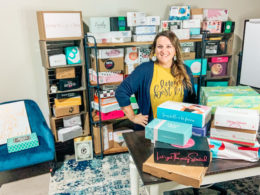To gain insight into the process of identifying and navigating significant business pivots, we reached out to CEOs, founders, and other business leaders to share their personal experiences.
From pivoting to virtual team-building events to expanding into energy storage solutions, discover 17 unique stories of successful transitions and the lessons learned along the way.
Pivoting to Virtual Team-Building Events
Our business went through the enormous pivot of providing in-person experiences to virtual team-building events—virtually overnight!
As you might have guessed, the pandemic necessitated this change. When lockdowns shuttered museums for the foreseeable future, we knew we needed to adapt to survive and saw the opportunity in providing team-building experiences to remote teams and companies who had never worked virtually before.
Thus, our sister brand TeamBuilding.com was officially born and began to grow. We navigated the change by creating a strong baseline product that could be brought to market quickly, building up our SEO and online marketing presence quickly, and hiring rapidly to keep up with outrageous demand. The result was an early market lead in a quickly growing industry and a huge boom of business in our first year as a new brand.
Tasia Duske, CEO, Museum Hack
Adding App Features for Growth
At Rephrase, we pivoted from being a single-use case productivity app to being a broad application with paraphrasing, text generation, and translation.
We realized that using AI isn’t limited to generating content. If a user wants to get instructions on how to do something, they can request an AI-generated step-by-step guide. In the same manner, they can have their 200-word blog post converted into a 1,000-word paraphrased piece more suited for inclusion in a magazine or website.
Pivoting to this model helped us gain more users than ever before and our revenue continues to grow.
Matthew Ramirez, CEO, Rephrase
Going from Blog to Travel Company
My company started as a blog sharing information about the best ways for tourists to make the most of their trips to Las Vegas. It highlighted all of the best places to visit and shared tips for those sites.
However, I realized there was much more I could do to help people maximize their trips to Vegas, so I pivoted and created a travel company. We still offer advice and the blog is full of information and resources, but now customers can book their trips with us as well.
To successfully make this transition, I did a lot of market research to see what customers wanted, what was working, and what wasn’t for other businesses in the travel industry and learned about trends in travel technology. This allowed me to create a business catering to customers’ needs while capitalizing on industry and tech trends.
Jenna Nye, CEO, On the Strip
Register for Small Business Digital Ready to discover and access free small business-focused events.
Adopting Technology for Faster Checks
As a company that offers background checks for potential candidates being hired by companies, there was a huge struggle to provide clients with accurate results in a timely manner.
In fact, during the pandemic, the hiring process was reduced significantly and with it many companies removed the extra time and cost of background checks, risking high-quality candidates in the process. That’s when we started adopting new technological advancements that helped speed up the process, allowing companies to reduce the time to hire while still integrating background checks in their hiring process.
Max Wesman, Chief Operating Officer, GoodHire
Focusing on One Insurance Type
I firmly believe that you should never stop testing new things for your business, even if what you’re doing is “working.” That’s how we decided to offer only one type of insurance rather than try to be a jack-of-all-trades like most other agencies.
Rather than trying to do it all, we focused and became the best at final expense insurance. Continuous testing allowed us to add over 15 different insurance providers rather than the usual 1 or 2, so we could serve customers better and more conveniently than the competition. Our pivot was more of a slow turn, pushing us closer and closer to becoming experts in our category.
Once you’ve decided to pivot, the plan to achieve your new direction can be composed of smaller steps. You don’t need to leap immediately unless sticking with the status quo will kill your cash flow or revenue.
Anthony Martin, Founder and CEO, Choice Mutual
Shifting to Dark Web Monitoring
As a startup founder, we underwent a significant pivot, shifting our focus from offensive cybersecurity tools to specializing in dark web monitoring for enterprise security teams. This change was driven by customer feedback and the increasing demand for threat intelligence technologies.
To navigate the transition successfully, we prioritized team training, hiring OSINT experts, and adapting our development processes. We effectively communicated the pivot to our existing clients, rebranded our company, and conducted client education and consultations to highlight the advantages of our threat intelligence solutions.
This strategic shift enabled us to capitalize on opportunities within the expanding threat intel market, attracting new clients and establishing ourselves as industry leaders in dark web monitoring.
Josh Amishav, Founder and CEO, Breachsense
Identifying Change and Navigating Transition
We identified the need for change by closely monitoring market trends and customer feedback. It became evident that our existing product was not meeting evolving market demands. Recognizing this, we conducted thorough research, engaged in discussions with our team, and sought external expertise.
We formulated a clear vision for the new direction and communicated it transparently. We encouraged open dialogue, embracing feedback from employees at all levels.
To ensure a smooth transition, we invested in upskilling our workforce and revisited partnerships to align with our revised objectives. Remaining agile and flexible, we monitored key indicators, customer satisfaction, and market reception to make necessary adjustments.
It was not without challenges, but by staying true to our values, maintaining a customer-centric focus, and fostering innovation, we successfully navigated the transition.
Luciano Colos, Founder and CEO, AI Pitch Deck Generator
Moving to Group Training Classes
I used to focus solely on one-on-one personal training. But then I noticed a trend among my clients. They loved the social aspect of training, especially when they occasionally ran into each other during sessions.
Recognizing this, I decided to introduce group training classes. It was a significant shift. However, I felt the change would benefit my clients and my business. But to navigate this transition successfully, I had to carefully plan the logistics and ensure I was equipped to manage larger groups.
I recall one of the first group sessions I held; it was a small group of four clients who had similar fitness levels. The energy in the room was palpable, and their enthusiasm confirmed I’d made the right choice. Today, group sessions are a staple in my business and are loved by my clients.
The key takeaway? Pay attention to your client’s behavior; they often hint at what they need or want.
Evander Nelson, NASM-certified Personal Trainer, evandernelson
Navigating Business Acquisition Challenges
When we started our business three years ago, we knew we wanted to become the most prominent business and finance publication in the world. My founder and I already had some background and experience working in successful online media. We were confident that we had the skills and expertise to move forward.
So, we started, and soon enough, we gained quite some traction. However, about two years into operations, we were acquired by a much bigger publication, and a lot of big changes started to happen.
First, we had to integrate a new team of editors, and our focus in terms of content changed significantly. Although we were not against these changes, managing the transition took a lot of time and effort. But eventually, we were able to maintain open lines of communication that ultimately made things work out.
Young Pham, Founder and Project Manager, Biz Report
Building a Sustainable Model
For our company, we initially intended to build a digital financial education business geared towards being a marketplace for online personal finance courses. However, things didn’t go as planned, and we felt the need to introduce a few tweaks in the aspects of our brand and how we target a niche.
Of course, pivoting was difficult to implement. We considered different factors such as product-market fit, business metrics, benchmarks, thresholds, product value, and opportunity cost. The hardest thing about a pivot, though, is committing to the pivot. It can be tempting to take shortcuts for quick revenue, but these shortcuts can seriously impact the success of the pivot.
Since our initial business plan was not viable in the long term, we chose to pivot to a business model that is more sustainable. We were able to successfully establish our company, Moneyzine, which has been offering free, impartial, and expert financial advice to our global audience for two decades now.
Jonathan Merry, Founder, Moneyzine
Broadening the Software Ecosystem
We first built our software as a route planner for drivers to eliminate last-mile delivery challenges that couldn’t be solved by the products currently on the market. Though delivery drivers continue to be our main customer, we’ve expanded and shifted our product as it became clear that the issue went well beyond the driver.
So to deliver in the way we truly want to, we’ve expanded our platforms to fix the experience for all parties in the ecosystem—drivers, retailers, and customers.
Jack Underwood, CEO and Co-founder, Circuit
Most Read: What Is the Average Income of a Subway Restaurant Franchise Owner?
Guaranteeing Organic Traffic Increase
As an SEO agency, we made a significant pivot from offering an ROI guarantee to guaranteeing organic traffic increase. Initially, we guaranteed ROI based on the calculation of Marketing Qualified Leads (MQLs) from SEO.
However, we realized this model had its pitfalls as ROI was heavily dependent on conversions, which could be influenced by changes the client made to their website, outside of our control.
Identifying this issue, we successfully transitioned to guaranteeing an increase in organic traffic—a metric directly within our purview. This pivot not only set realistic expectations but also reaffirmed our commitment to deliver tangible results.
Jaya Iyer, Marketing Assistant, Teranga Digital Marketing
Embracing Rebranding and Adaptability
Our moment of truth at Sip Herbals came during a large tradeshow. We quickly realized that our brand messaging wasn’t resonating with the broad market. Swiftly acknowledging this, we brought on a rebranding agency to pivot our messaging.
Navigating this transition was challenging but rewarding. With a renewed brand story, we managed to connect more effectively with our audience. This experience underlines the necessity of adaptability and a customer-centric mindset in driving business growth.
Kelly Raulerson, Co-founder, Sip Herbals
Transitioning to a Flat Fee Model
When I started my consulting business, I charged an hourly fee. Not only did this model not allow me to plan my time accordingly between clients, as they always seemed to want more of me, but I also realized that I was getting deeper into the client’s business (and with one client felt like I was running their business).
To set clear boundaries and be able to manage multiple clients at one time better, I moved to a fixed flat fee model. The flat fee model helps my clients to budget for the investment in my services while allowing me the freedom not to be watching the clock and giving the time needed for each client. While the pricing varies by client and scope of work, the model has worked well in scaling my business.
Kimberly Bogues, Founder/CEO, Flourish Business Consulting
Growing to Direct-to-Consumer
I started my business 15 years ago. We are an online dental lab, but when we first started, we sold online and also worked with local dentists on making their products. Three years in, we decided it was time to pivot away from working with local dentists and focus on the online part of the business. It was a hard decision to make.
Working with local dentists was 50% of the business, but it took 80% of our focus, and we knew there was a limit on the amount of growth we could achieve working with only local dentists. We did slow down for a few months while we tried to grow the online portion of our business. It was a gamble, but in the end, it paid off, and now we only deal with direct-to-consumer.
Evan McCarthy, President and CEO, SportingSmiles
Specializing in the Tech Sector
As a recruiter launching a firm in a competitive market, my first instinct was to aim broadly and work in multiple sectors and industries. But I soon fell into the jack-of-all-trades, master-of-none conundrum.
Niching down can be intimidating for business owners. It’s natural to feel like limiting your scope will lessen your customer base. But the opposite is true. Once I accepted that tech was my true passion, I was able to narrow my vision in a way that made clients take notice.
One key was reducing my focus slowly: pivot implies a quick change, but it’s usually more beneficial to shift incrementally to your new specialty. This ensures you’re not closing off relationships before you’ve built fresh ones.
Rob Reeves, CEO and President, Redfish Technology
Expanding into Energy Storage Solutions
We once found ourselves facing a saturated market with dwindling profit margins. We identified the need for change when we noticed an uptick in customer inquiries about solar storage solutions—not just installation. It was a eureka moment.
We decided to pivot our business from solely focusing on solar panel installation to including energy storage solutions. To navigate this transition smoothly, we trained our team on new technologies, partnered with battery storage manufacturers, and revised our marketing strategy.
The process was challenging, but the willingness to adapt and embrace change was our key to success. Now, we’re not just providing renewable energy but a completely sustainable power solution.
Haya Subhan, General Manager, Solar Panel Installation
Photo by Austin Distel on Unsplash






